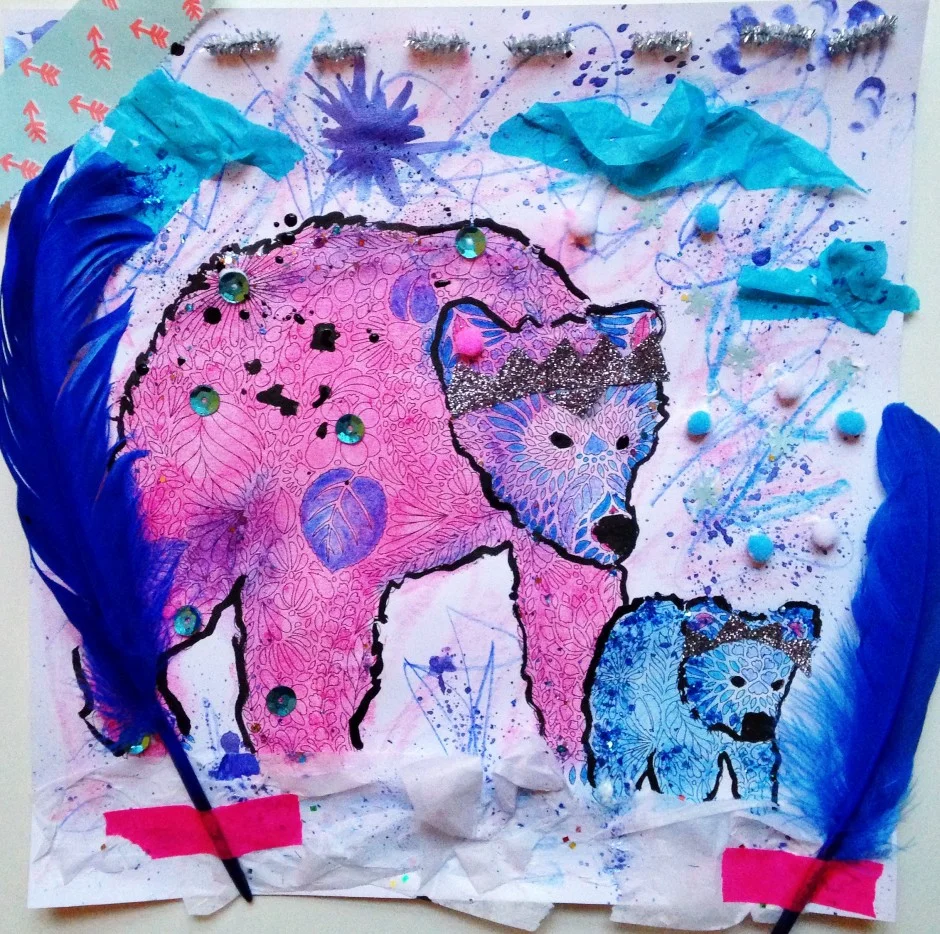Adult colouring books are currently all the rage. I’m sure you’ve seen them lining the shelves of book stores and art stores alike – I even found one while picking up groceries! Some of the adult colouring books are advertised as “art therapy” and promise to help you colour your way to happiness or a stress-free life. So what’s this fad all about? Do these claims hold any truth? And what’s the difference between colouring and art therapy?
First of all, what’s behind the adult colouring books craze? We think the attraction may lie in the fact that colouring pages offer a sense of control. We live in a world where there are so many things that we can’t control – traffic, the weather, the economy, other people . . . sometimes even our own emotions. We live with an underlying anxiety because we want control but often we can’t have it. Working with pencil crayons or markers to fill in spaces on a colouring sheet offers an experience of control. You get to choose the colours, create the patterns, and stay within the lines. It can feel empowering to turn the page into your own creation, your way.
What about claims related to stress relief? In our increasingly digital world we are often required to attend to multiple things at once, and for many of us the majority of our day is spent looking at a screen. There’s something magical about returning to physical pencil and paper. The opportunity to focus on the single task of filling in a pre-existing design can provide some respite from the chaos. Concentrating on colouring for 20 minutes can be a great way to take a break and recharge. If you are feeling stressed about a situation but nothing can be done at the moment, working on a colouring page may allow you to focus on something else and distract yourself from the worrisome situation. In addition, the repetitive activity of choosing colours and filling in spaces can be soothing, similar to the way that some people find knitting to be relaxing. We know of a friend who brings colouring books to chemotherapy as a way to distract and soothe herself while sitting and waiting during treatments.
Can we really colour our way to happiness? Research supports the idea that being creative makes people feel good. Colouring is a creative activity that doesn’t require many supplies, doesn’t make a mess, and can be done almost anywhere. The pre-existing design may feel less intimidating than a blank page, and you can stop and start at any time, picking up from where you left off. It may feel satisfying to work towards a tangible goal and track your progress as the page is gradually is completed. In the end you have something to show for your efforts and you can be proud of the results. Dr. Donna Betts, President of the American Art Therapy Association, commented that adult colouring books “provide a pathway to the life-affirming pleasures of making art” (Press Release, January 19, 2016). The American Art Therapy Association suggested that the adult colouring phenomenon is reminding people of the importance of art as a component in health and wellness, and stated that colouring can be beneficial as a self-care activity (for more information about self-care check out our past blog post).
So, colouring may offer an experience of control, provide distraction from stressors, or help you to focus. It may be a soothing activity that allows you to tap into your creativity, and may result in positive feelings like satisfaction or pride. Working in a colouring book may bring pleasure or happiness through art-making, and may contribute to health and wellness. But what if it doesn’t? For some people, the idea of colouring may trigger memories of negative school experiences, critical messages about not staying inside the lines, or struggles with fine motor skills while learning to write and draw. The intricate designs may feel overwhelming to some people, and filling in the tiny spaces may be frustrating or discouraging. Some people may feel that the pre-determined designs limit their creativity. We’re not trying to discredit the positive effects experienced by so many but to clarify that those experiences are by no means universal and that different experiences are completely valid as well.
While some adult colouring books are advertised as “art therapy,” there is a very real difference between colouring on your own and attending art therapy. In an art therapy session, there are three key components. First, there’s the therapeutic relationship between the client and the trained art therapist. Second, there’s the art-making process. The art therapist acts as a witness to the creative process, and the therapist’s observations about the process can lead to insight and self-discovery for the client. Witnessing and observing takes place within the context of safety and trust established in the relationship. Finally, there is the art product. Unlike the pre-determined designs in colouring books, art therapists do not define what the art product will be. Usually, the goal in art therapy is to open the client up to new possibilities and new ways of thinking and acting. This means following the artistic process to see where it takes you. So in a way, the objective is quite opposite to the structure and control provided by colouring sheets.
However, there are certain times when colouring pages can be an integral part of art therapy. For instance, colouring books have been used as therapy for clients with dementia to help reduce depression and anxiety, to improve mood, and to help with focus and fine motor skills. Check out the following video link to see the awesome work that’s being done at Memories & Company in Markham: http://www.citynews.ca/2016/01/14/video-adult-colouring-books-being-used-as-therapy-for-those-with-dementia/.
So, once again, it’s all about balance. Colouring books have great value and colouring within the lines can be beneficial in many ways. But we also love all that space and possibility outside of the lines! As you can see in the image above, we had some fun with a colouring page by exploring beyond the page. We encourage you to explore your creativity today, inside or outside of the lines. Happy colouring from Art as Therapy!
References:

